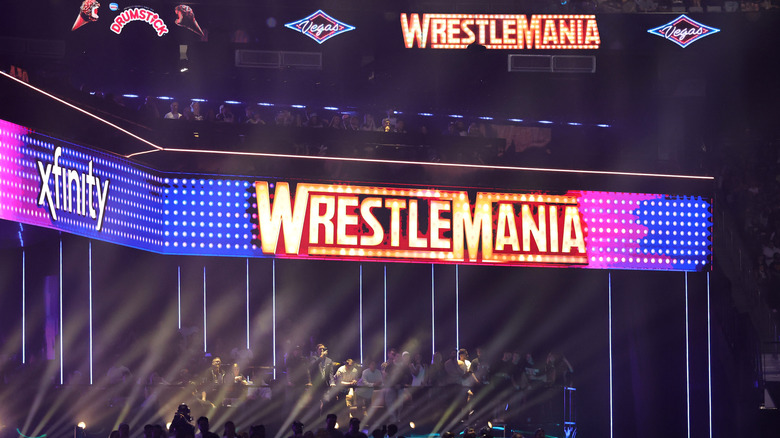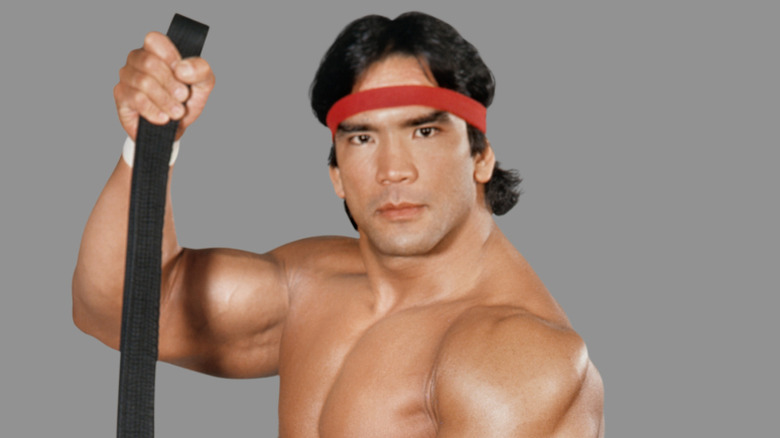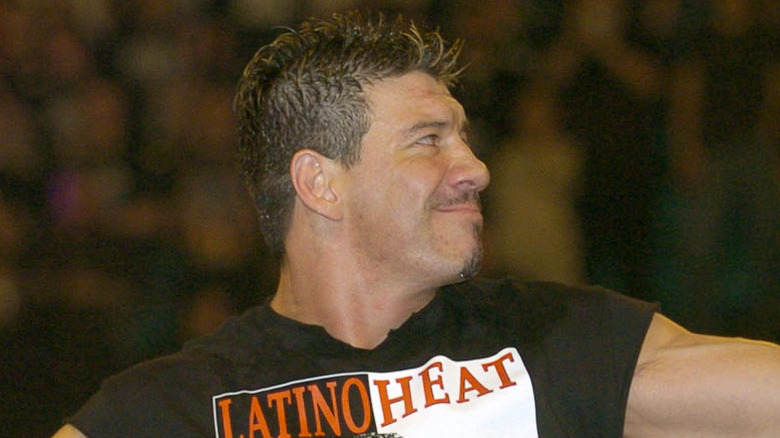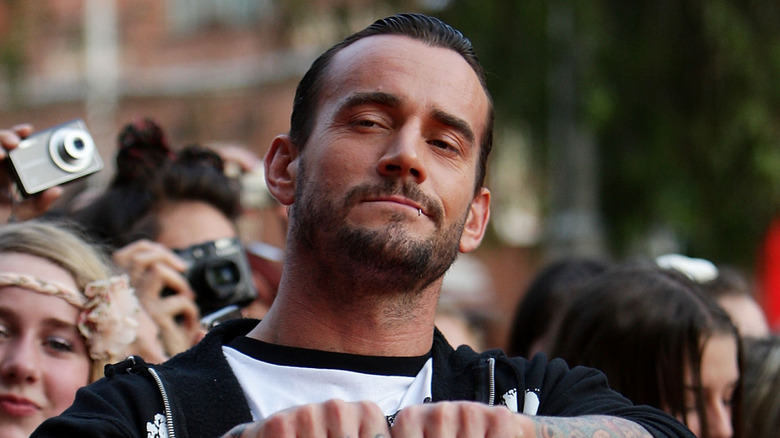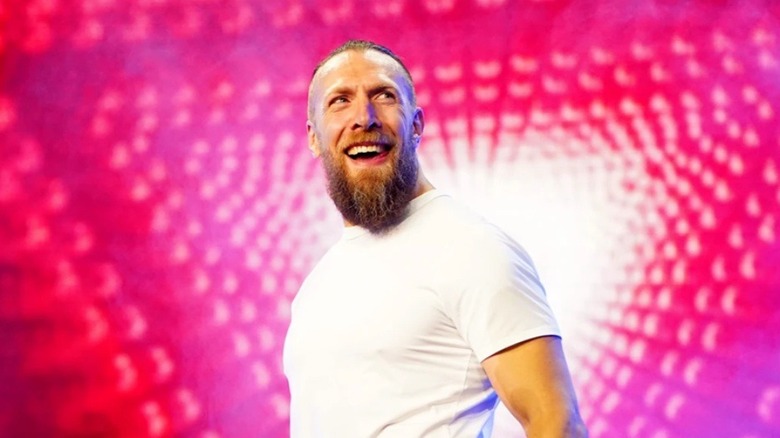The Best PPV Cards In Wrestling History
Ever since Vince McMahon first popularized the format back in the 1980s, there have been hundreds upon hundreds of professional wrestling events held on pay-per-view. Depending on how you view Internet PPV platforms and streaming services, there's been more promotions than you can count that have tried their hand at the format. As such, wrestling on PPV has been established as a premium form of content as far as wrestling cards go, so much so that WWE began labeling their events "premium live events" instead of PPVs a few years ago. And yet, it is very rare where a PPV event winds up being considered one of the greatest events the wrestling world has ever seen.
Of course, quality is a thing that only holds water in the eye of the beholder, and as such, a "great" PPV card can be determined by multiple factors. How many great matches were on the show? How many "moments" or "happenings" took place, such as an angle, swerve, a surprise debut, or something along those lines? Did the PPV end up having staying power from a historical perspective? In the end, all of those things have helped determine PPV events that wrestling fans consider to be, as "Macho Man" Randy Savage would say, the cream of the crop. And with the vast majority of WWE's legendary shows already well documented, here's a look at three PPV's outside the WWE bubble, and one inside of it, that, for a variety of reasons, are events fans rank among the all-time greats.
WCW Spring Stampede 1994
Taking place just a few months before Hulk Hogan arrived on the scene, the inaugural Spring Stampede is part of a period of WCW history that's mostly been forgotten. That's not all that surprising; not only did Hogan's run lead to WCW's hottest period a few years later, but WCW prior to 1994 had been a bit of a mess, thanks to a disastrous start to the 1990s under the stewardship of Jim Herd and "Cowboy" Bill Watts. As such, the event is very much a straight forward wrestling show, one that doesn't have the historical significance of the 1996 editions of The Great American Bash and Bash at the Beach, two well received shows that officially kicked off the era of the New World Order.
What Spring Stampede does have, however, is an eight match card with strong wrestling and all sorts of variety. There's up and comers like Diamond Dallas Page and Johnny B. Badd duking it out in the opener, the first of many battles the two would have, a styles clash between Steven "Don't Call Me William" Regal and Brian Pillman, a Chicago Street Fight, a Bunkhouse Brawl, a hoss fight, and several major (or soon to be major) stars in Sting, Rick Rude, Cactus Jack, Steve Austin, The Great Muta, Vader, and The Boss, aka The Big Bossman. And it's all punctuated by Ric Flair and Ricky Steamboat battling to a 30 minute draw in the main event, a match that, if it didn't quite reach the heights of the duo's trilogy in the late 80s, comes awfully close. It may not have featured a third man, but the 1994 Spring Stampede remains a shining example of a top to bottom wrestling card filled with great action.
AAA When Worlds Collide 1994
Long before CMLL's partnership with AEW and WWE's purchase of AAA, the first "major" moment lucha libre had in the United States was the latter's When Worlds Collide, taking place in the LA Sports Coliseum in November 1994. And while it's true When Worlds Collide was technically AAA's US breakout, broadcasting on PPV thanks to help from WCW, it was in many ways a culmination. Founded by former CMLL booker Antonio Pena in 1992, with help from Televisa, AAA had been riding a two year wave of momentum that saw them seriously challenge CMLL for top promotion in Mexico, while running shows in Los Angeles that outdrew both WWE and WCW. When Worlds Collide wasn't just a statement, it was a final statement, showing lucha libre was here, and here to stay in the US.
Despite meddling from WCW regarding the card, the event succeeded in doing just that, introducing the world to names like Rey Mysterio, La Parka, Eddie Guerrero, Art Barr, Blue Panther, Latin Lover, Perro Aguayo, and Konnan. But it's ultimate claim to fame remains the semi-main event, where Guerrero and Art Barr, known as Los Gringos Locos, battled El Hijo del Santo and Octagon in a two out of three falls mask vs. hair match. With incredible heat, high flying action, a couple of devastating piledrivers from Barr to Octagon and Panther (interfering to attack Barr), and plenty of other twists and turns, the match continues to be considered among the greatest lucha libre matches in history, as well as a tragic coda for Barr, who died just weeks later. It would also become the catalyst for the event's reputation, and a comparison point for other "breakout" PPV's such as the original All In, AEW Double or Nothing 2019, or WWE's own Worlds Collide event decades later.
WWE Money in the Bank 2011
This is a PPV that may make some fans wince, in large part because of what came after. Indeed, the only thing more memorable than the 2011 edition of Money in the Bank is how WWE, in the eyes of many fans, dropped the ball afterward, taking a lightning in the bottle moment involving CM Punk and neutering it with the involvement of Alberto Del Rio, Kevin Nash, and especially Triple H. But it's the greatness of Punk and Cena's encounter at Money in the Bank that ultimately overrides the bad ending months later and keeps it among the best WWE matches ever. Lasting nearly 34 minutes and backed by an incredible build up and one of the greatest "homefield advantage" crowds in wrestling, Punk and Cena created a masterpiece, so much so that it is still considered the highlight of each man's career, and in Punk's case helped mold him into an anti-establishment hero.
But the dirty little secret of Money in the Bank 2011 is that, for all of Cena vs. Punk's greatness, it's not a one match card. Both Money in the Bank matches proved to be very exciting, with Daniel Bryan's victory in the "SmackDown" Money in the Bank bout that opened the show beginning a journey that would lead to Bryan becoming one of the biggest stars of the 2010s. Though not a great match, Mark Henry's clash with Big Show would be the start of Henry's "Hall of Pain" run, considered by many to be the best period of his Hall of Fame career. And after months of being bettered by his rival, Christian finally outsmarted Randy Orton to win back the World Heavyweight Championship, prompting Orton to demolish him in a memorable post-match angle. In the end, only the 5 minute women's match between Kelly Kelly and Brie Bella was forgettable, a sign that women's wrestling was still a ways away from where it would wind up.
AEW All Out 2021
If there's one thing most people can agree on when it comes to AEW, it's that the promotion largely delivers when it's time for a PPV event. As a result, it's become part of the problem when trying to determine which AEW PPV is the greatest. Strong arguments could be made for AEW's first ever event, Double or Nothing, in 2019, along with all three AEW All In's, All Out 2023, AEW Revolution 2023, and most recently AEW Double or Nothing earlier this year. But even with all the debate, the one AEW show many fans have gone back to is AEW All Out 2021, simply because it had a little bit of everything.
Now sure, there have been AEW PPV's some would point to as having more great matches than All Out 2021 had. Few AEW shows, however, have featured a card that, up and down, is as consistent, with all but the Paul Wight vs. QT Marshall match considered to be good to great, while the Lucha Brothers vs. Young Bucks steel cage match was hailed as an instant classic. But what ultimately sets All Out over the top is the "other stuff" that went along with the matches. CM Punk's AEW tenure may have ended badly, but his first wrestling match in seven years will always be against Darby All In at All Out, in front of Punk's hometown of Chicago. And then there's the debuts, from Ruby Soho's appearance in the Women's Casino Battle Royale (which she won), to the double debut of Adam Cole and Bryan Danielson following the main event between Kenny Omega and Christian Cage, a moment that still may be AEW's most iconic.
